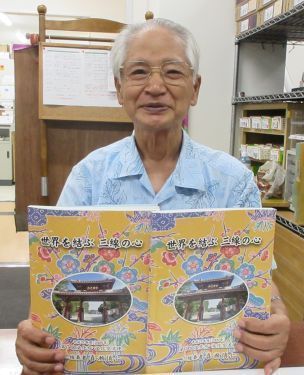Uniting the world with Okinawan sanshin, Shinjin Kise’s new book details his work abroad

Shinjin Kise poses with his book, which details his activities as a cultural ambassador, and is dedicated to the next generation. Photographed on July 9 in Okinawa City.
July 21, 2021 Ryukyu Shimpo
By Takeshi Kishimoto
Shinjin Kise, the 78-year-old master of the Nomura School and Tansui School of Classical Okinawan Music Preservation Society, published the book, Linking the World: The Heart of the Sanshin. Kise, who now resides in Tobaru, Okinawa City, is the first to be dispatched from the prefecture by the Agency for Cultural Affairs as a Cultural Exchange Ambassador to five countries. The book is not only a valuable compilation of his work as an ambassador but also lays out the essence and cultural value of classical Okinawan music, a source of pride for the prefecture. It is also an autobiography of Kise’s 50-year career with the Okinawan sanshin (three-stringed instrument).
Kise’s cultural exchange work across five countries
In addition to serving as a professor at the Okinawa Prefectural University of Arts, Kise is a designated holder of a Nationally Important Intangible Cultural Property in kumiodori (general certification, uta-sanshin jiutai, or singing sanshin) and a designated holder of the Prefectural Intangible Cultural Property in Nomura School of classical Okinawan music. Kise has traveled to 27 countries thus far; In 1994, he recorded all 204 songs of the Nomura School of classical music on 12 CDs and received an award from the Okinawan government for his cultural contribution. He is also the current president of the lifelong learning facility Peare Rakuen and Kouju College.
In 2009, Kise was appointed Cultural Exchange Ambassador by the Commissioner of the Agency for Cultural Affairs. In August the same year, he left Okinawa for six months and traveled to the Philippines, China, France, Germany, and the United Kingdom, giving 26 demonstrations, 76 practical instruction sessions, 5 lectures, and 17 workshops. At Fujian Normal University in China, which has close ties with Okinawa, Kise taught about 60 hours of classes and collaborated with a local performance group called Pingeki, which was widely broadcasted by the local media.
During his travels, Kise contributed articles to this newspaper and other media as a correspondent. In addition to classical Okinawan music, Kise would perform folk songs that are well-known to most Okinawans—numbers like Asadoya Yunta, Warabi Gami, and Hana, while incorporating the kachashi dance. He recalls that the assorted Okinawan entertainment culture “transcended language barriers and united the audience.” Okinawans abroad supported Kise wherever he visited as he traveled alone. He gave special thanks to Yoko Oshiro, a correspondent for this newspaper reporting from France, saying, “She helped me very much and I felt the strong bond of uchinanchus.”
Kise published 350 copies of his new book, in which he details the exchanges he had in each country and offers newspaper materials and photographs. Kise eagerly wrote, “[I] was able to spread Okinawan culture to the world.” In his lectures, he emphasized pacifism as a foundation of classical Okinawan music, which also makes up the five key Okinawan concepts: the Nirai Kanai religion, ichariba cho de (once we meet, we are family), chanpuru (mixing) culture, the spirit of yui maaru (mutual support), and nuchi du takara (life is precious).
Kise gifted the book to his apprentices and other associates and said, “I want the younger generation to grow into leaders and messengers to the world. I hope my book will help them in their development.”
(English translation by T&CT and Monica Shingaki)
Previous Article:“I Want to Bring Back the Rice Fields” Cultivating Unused Land and Revitalizing Rice Farms that Supported an Island
Next Article:After Okinawa and Amami made the World Natural Heritage List, Governor Tamaki affirms they need to “Make it last 1,000 years”
[Similar Articles]
- Kumiodori performers to go on European tour to France, Germany and Italy
- Blind Student Mitoya chases her dream to be a Sanshin singer
- Sanshin fans promote Okinawan culture in Paris
- Gifting project seeks sanshin donations to send to France
- Okigeiren kicks off its European tour in Paris, enchanting audiences
 Webcam(Kokusai Street)
Webcam(Kokusai Street)


